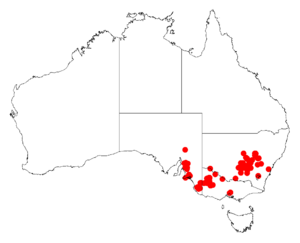Acacia trineura facts for kids
Quick facts for kids Acacia trineura |
|
|---|---|
| Scientific classification | |
| Genus: |
Acacia
|
| Species: |
trineura
|
 |
|
| Occurrence data from AVH | |
The three-nerve wattle (scientific name: Acacia trineura) is a type of wattle tree or shrub. It is also known as the three nerved wattle or green wattle. This plant grows naturally in southeastern Australia.
About the Three-Nerve Wattle
This wattle is usually a shrub or a small tree. It can grow from 1 to 5 m (3 ft 3 in to 16 ft 5 in) tall and often has a rounded shape. Its small branches are a bit angular and covered in fine, whitish hairs. They also have sticky, resinous ridges and smooth, grey bark.
Like most Acacia species, the three-nerve wattle has phyllodes instead of true leaves. Phyllodes are flattened leaf stalks that look and act like leaves. These phyllodes are smooth and slightly leathery. They stay green all year round.
The phyllodes are shaped like an oval that is wider at the top, or like a spearhead. They are typically 3 to 7 cm (1.2 to 2.8 in) long and 4 to 11 mm (0.16 to 0.43 in) wide. They can be straight or slightly curved. You can see three clear, sticky main veins on them. These veins are pressed into low ridges, and many smaller veins surround them.
Flowers and Seed Pods
The three-nerve wattle blooms between August and October. Its flowers grow in groups of three to eight on a short stem, which is 2 to 15 mm (0.079 to 0.591 in) long. The flower-heads are round and small, about 3 to 5 mm (0.12 to 0.20 in) across. Each flower-head has 12 to 25 pale yellow to yellow flowers.
After the flowers, papery seed pods form. These pods have a few hairs and are mostly straight and flat. However, they are raised over each seed and pinched in between them. The pods are 3 to 8 cm (1.2 to 3.1 in) long and 2 to 3 mm (0.079 to 0.118 in) wide. Inside, the seeds are shiny black, about 4 mm (0.16 in) long, and oblong in shape.
How it Was Named
The botanist Ferdinand von Mueller first officially described this species in 1863. He wrote about it in his work called Fragmenta Phytographiae Australiae. Later, in 2003, another botanist named Leslie Pedley reclassified it. However, in 2006, it was moved back to the Acacia group.
The scientific name trineura comes from Latin. It refers to the three main veins that are easy to see on the phyllodes. Scientists believe this wattle is closely related to Acacia redolens, which is found in Western Australia.
Where it Grows
The three-nerve wattle is found only in southeastern New South Wales, northern Victoria, and southeastern South Australia. This means it is endemic to these areas.
In New South Wales, you can mostly find it between West Wyalong, Condobolin, and Forbes. It usually grows in red earth soils as part of mallee plant communities.
In Victoria, it grows in the Lowan Mallee, Murray Mallee, and Wimmera regions. Here, it is often found near water sources in red earth or clay soils. This species is considered a vulnerable species in Victoria, meaning it needs protection.
In South Australia, it is considered rare. It is only found in the southeastern part of the state, southwest of Naracoorte. It grows there in dark but shallow cracking clay soils.

